
Blog: A difficult resupply for the Antarctic expedition
The researchers on expedition to Antarctica were on their way to the German polar base ‘Neumayer’, for resupply of foods and fuel for the coming year. However, in the Antarctic things are not always that easy. The bumps in the road to Neumayer require a bit of background on different shapes and names of ice.
Photo: The edge of ice shelf at a point without fast ice: too high to use cranes for dry content containers, but just manageable to pump fuel ashore.
Fresh shelf ice
Snow makes the Antarctic icecap grow to a height of several kilometres in many of its central parts. But like in all glaciers, the ice slowly flows to its lower outer margins. The weight of the ice pushes large parts of the Antarctic continent to below sea level. Because of that, the ice may flow slowly into the sea without breaking off directly. These floating margins of the ice cap are known as the ‘ice-shelf’. The shelf ice is tens to hundreds of meters thick, of which the major part remains below the water. Only now and then, outer bits may break off: those are the flat tabular icebergs that later modify into erratic shapes by melt, breakage and overturning. Shelf- and iceberg ice are popular among whisky lovers: it’s the most pure fresh water, many centuries of age that gives an extra sparkling in the glass by the high pressure under which enclosed air-bubbles have been compressed.
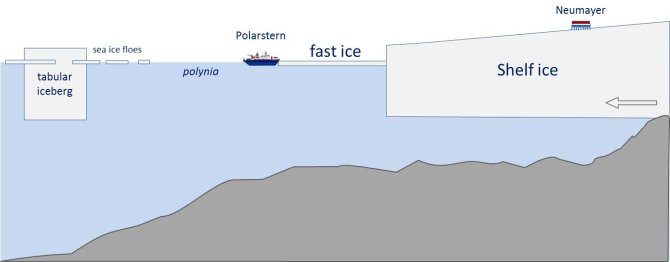
Salty sea ice
Sea ice is a different story. Around the Antarctic, every winter the sea freezes over a huge area of about 20 million square kilometres. After summer melt only a residual sea ice area of about 4 million km2 remains. Most of this sea ice is even in winter continuously broken up by winds, currents and tides, into loose separate floes. However, against the coast or ice-shelf, such floes may freeze together into a continuous compact and thick layer of so-called ‘fast-ice’ which may only break up in late summer. If winds come from the continent, open water areas (polynias) may develop in between the fast ice and the floe ice areas.
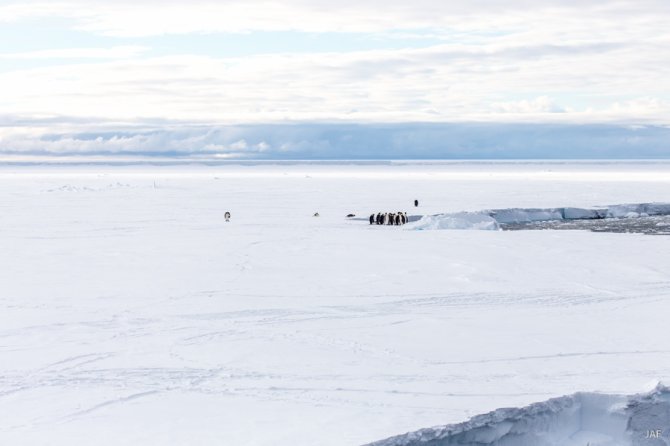
Offloading containers
Neumayer base is positioned on the floating ice shelf (and moves to sea at a speed of about 30 cm per day). When we arrived here, on the 25th of December, solid fast-ice of several kilometres wide prevented access to the usual spot at the shelf for offloading supplies. But as we had no choice, Polarstern rammed the fast ice for several days at full engine power to break an access to the shelf. However, about half way we’ve had to decide to offload the dry good containers onto the sea ice: around the ship the ice was around three metres thick with an additional layer of compacted snow of at least one metre. Unfortunately, fuel pumping and pulling fuel-containers over sea ice is too dangerous and required a later alternative solution. But normal containers could be towed on Pistenbully sledges over the sea ice to Neumayer, about 20 km further south. At a favourable spot with much snowdrift and some additional snow a ramp had been made along which sledges could be pulled from the fast-ice onto the about 10 m higher ice shelf.
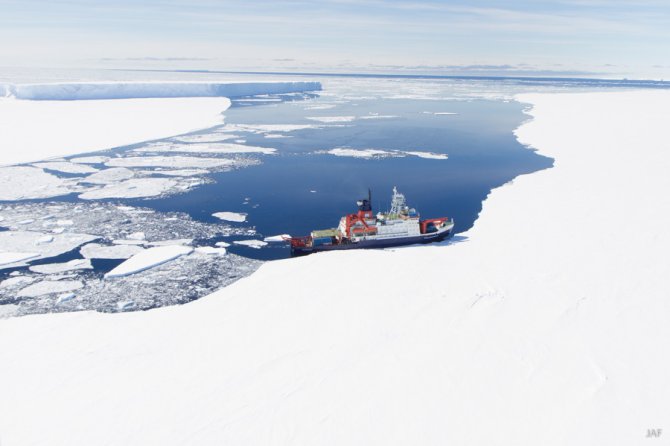
New Year celebration
The offloading of containers onto the sea ice took us into the new year. We celebrated New Years Eve on the ship with a big dinner in the heli-hangar, and a champaign reception on the Monkey Deck where the scheepshoorn blew the old year away and the midnight sun welcomed the new year with a glare on distant icebergs.
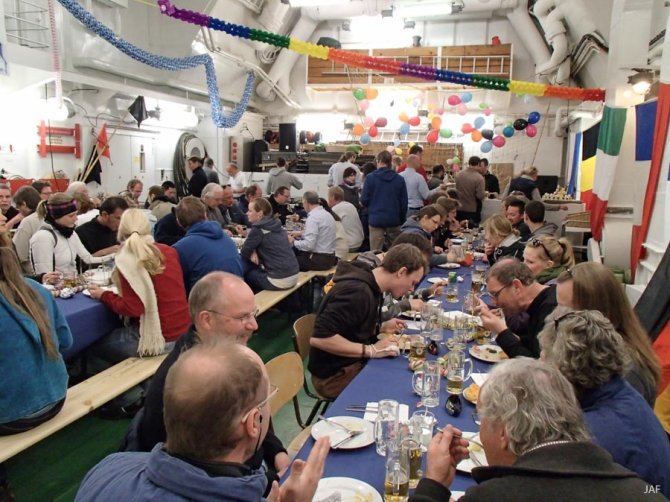
High shelf ice edge
Today, the 2nd of January 2015, we have changed position to a fast ice free edge of the ice shelf, at much greater distance from the station with the edge rising to at least 40 metres above the water. That is way too high to lift containers onto the shelf. But assisted by helicopter, the materials needed for the pumping of fuel could be lifted onto the shelf. From the ship we can only see the fuel hose to the sky and don’t notice anything else from the activities on top where the Neumayer crew is busy with the filling of fuel containers. Sufficient fuel is crucial for the winter at Neumayer. At least another day will be dedicated to the pumping of fuel so we will still be here. What happens after is a wait and see.
‘Weather and ice permitting’ is an expression all too true in the Antarctic.
Jan Andries van Franeker, 2 January 2015
Southern Ocean, 70°34’ South – 09°03’ West, Air temperature -3°C
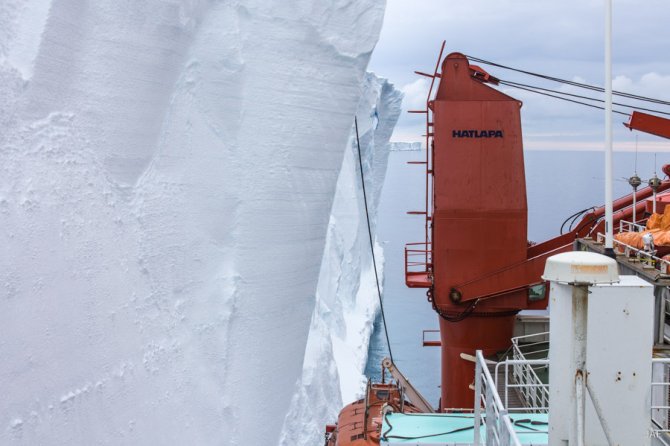
Re:actions 1
wur_forum_reactions_wrapper for object 43 of type wm_language nl_gx_webmanager_cms_core_implementation_languageimpl 2
-
Paula Nobel
Ha Jan Andries,
De allerbeste wensen voor 2015! Veel geluk, gezondheid en succes met de werkzaamheden.
Gaaf om jullie foto's te zien en om de uitleg erbij te lezen. Opnieuw indrukwekkend!
Veel succes nog met de werkzaamheden, en wij kijken uit naar de volgende update!
Groetjes,
Paula Nobel
Redmar Oosterkamp -
Jannie van Franeker
Allereerst:
De allerbeste wensen en veel geluk en gezondheid voor jou en je teamgenoten in 2015!
Wat een prachtige plaatjes van een heel bijzonder deel van onze wereld en de uitleg over het ijs was voor mij ook zeer nuttig!!!!!!
Hoop dat de verdere reis zonder al te grote problemen zal verlopen. Veel succes!
Jaeseuj9
This is highly informatics, crisp and clear.
ReactI think that everything has been described in systematic manner so that reader
could get maximum information and learn many things.
제이나인 마카오 카지노
제이나인 메이저 카지노 사이트
제이나인 안전 사설 토토 사이트
제이나인 안전 토토 사이트
제이나인 오래된 토토 사이트
https://www.j9korea.com